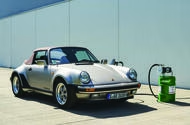The automotive industry is at a crossroads, grappling with the implications of an impending ban on new petrol and diesel vehicles. As we transition towards a more sustainable future, alternative fuel solutions are gaining traction. Among these, e-fuels are emerging as a potential player in the quest to reduce transport emissions alongside the electrification of vehicles. But what exactly are e-fuels, and how do they stack up against other alternatives?
Understanding E-Fuels: What Are They?
E-fuels, or electrofuels, are synthetic fuels designed to be carbon neutral. They can be utilized in internal combustion engines just like traditional petrol or diesel. The production process involves using ‘green’ hydrogen—derived from renewable energy sources—and carbon, which can come from waste biomass or CO2 captured from the atmosphere. This innovative approach allows e-fuels to potentially offer a cleaner alternative to conventional fossil fuels.
How Are E-Fuels Made?
The production of e-fuels begins with the electrolysis of water, where hydrogen and oxygen are separated using electricity. Afterward, CO2 is captured from the atmosphere and combined with hydrogen through chemical synthesis. The result is a fuel that, theoretically, emits the same amount of CO2 when burned as was used in its production, making it carbon neutral. This process is gaining interest from manufacturers like Porsche, who see e-fuels as a viable alternative to electric vehicles (EVs).
Are E-Fuels Truly Clean?
While e-fuels present a promising solution, the debate over their environmental impact is ongoing. Critics point out that, despite being cleaner to produce, e-fuels still emit harmful gases similar to those from petrol and diesel. For instance, recent tests by Transport & Environment revealed that e-fuels emit comparable volumes of nitrogen oxides (NOx) as regular fuel and even produce higher amounts of ammonia and carbon monoxide.
Moreover, the energy efficiency of e-fuels is a significant concern. According to Enerdata, vehicles running on e-fuels have an energy efficiency that is four to five times lower than that of battery electric cars. This raises questions about the overall effectiveness of e-fuels in the broader context of reducing emissions.
The Upsides of E-Fuels
Despite the challenges, e-fuels do have some advantages. For one, they can be produced using renewable energy sources like solar and wind power, which could make them a cleaner option compared to fossil fuels. Additionally, e-fuels can power existing internal combustion engines without requiring modifications, making them a convenient choice for consumers who want to transition away from traditional fuels without investing in new vehicles.
Another significant benefit is the compatibility of e-fuels with existing infrastructure. Unlike hydrogen or electric vehicles, which require new refueling stations and charging networks, e-fuels can utilize current fuel lorries, refineries, and filling stations. This means that drivers can refuel their vehicles in just a few minutes, similar to the experience they’re accustomed to.
The Drawbacks of E-Fuels
On the flip side, the production of e-fuels is currently costly and energy-intensive. The European Union would need to increase its energy production by 50% to generate enough electricity for widespread e-fuel use. Additionally, research indicates that nearly half of the renewable electricity used in the conversion process is lost, making it less efficient than directly powering electric vehicles.
Moreover, while e-fuels may be cleaner to produce, they still contribute to air pollution, emitting harmful gases that pose health risks to communities. This duality raises critical questions about the long-term viability of e-fuels as a sustainable solution.
Who’s Investing in E-Fuels?
Porsche is leading the charge in e-fuel development, having invested £62 million in pilot production in Chile, aiming for an annual output of approximately 130,000 liters. The company’s executives believe e-fuels could provide a nearly carbon-neutral alternative for the vast number of combustion engine vehicles still on the road.
Other manufacturers, including Volkswagen and Ferrari, are also exploring e-fuels as a way to extend the life of combustion engines. Mazda has expressed interest in e-fuels as a complementary solution to electrification, highlighting their potential impact on decarbonization given the high number of existing vehicles.
What Lies Ahead for E-Fuels?
While e-fuels hold promise, the UK government has yet to officially incorporate them into its emissions-reduction strategy. A recent report from the Transport Select Committee criticized the government for focusing solely on battery-electric vehicles, urging a more balanced approach that includes addressing the existing petrol and diesel fleet.
Concerns persist about the environmental impact of manufacturing carbon-neutral fuels. The energy required to produce hydrogen for e-fuels is substantial, and experts warn that prioritizing e-fuels could divert renewable electricity from other critical sectors of the economy.
Despite these challenges, the momentum for e-fuels is growing. Porsche’s partnership with Highly Innovative Fuels is paving the way for new production facilities, including a second plant in Texas. This development underscores the importance of utilizing renewable energy sources efficiently, particularly in regions with abundant solar and wind resources.
As the automotive landscape evolves, the conversation around e-fuels will continue to develop. The key takeaway? E-fuels aren’t just about replacing petrol and diesel; they represent a complex interplay of technology, infrastructure, and environmental considerations. As we navigate this transition, it’s crucial to remain open to a variety of solutions that can collectively contribute to a more sustainable future.

